How to Do Marketing Research in Less than 30 Minutes? Nike Case Study
Table of contents
Marketing research is a complex and time-consuming process, but what if I told you that you can do it in less than 30 minutes?! In 2026, with AI capabilities and the right tools, market research is no longer a tall order. You need only two things: a media monitoring project for collecting data and an AI Brand Assistant to analyze data for you.
Let’s say that in your market research, you want to learn about Nike’s online performance in the past 30 days.
It couldn’t be easier!

Marketing research is the process of gathering, analyzing, and interpreting information about a market, including its products, services, customers, focus groups, competitors, and industry trends, to support decision-making and strategy development. Usually, the market research process is resource- and time-consuming, but with the right tool, you can conduct it in less than 30 minutes.
So, if market research is one of your responsibilities and you have been struggling with it so far, you are in the right place!
Read further to compare 3 helpful tools and discover the secret to market research in 3 steps and less than 30 minutes.
Let’s go!
What is marketing research? Definition
Marketing research is your secret weapon for business success!
Imagine having a crystal ball that shows you what your customers really want, what your competitors are up to, and how you can win your target market.
That’s marketing research for you!
It’s all about gathering data, crunching numbers, and getting insights to help you make smart decisions.
Whether you’re launching a new product, improving your services, or just wanting to know what people think about your brand, marketing research gives you the answers.
It’s like having a superpower that keeps you one step ahead, ensuring you’re always in the know and ready to grow!
Purposes & benefits of marketing research
- Consumer research: Understanding customer needs, preferences, and customer satisfaction level
- Market analysis: Evaluating market potential and market share
- Competitor research: Analyzing competitor strategies and performance, evaluating market saturation
- Marketing efforts assessment: Assessing the effectiveness of marketing campaigns based on comparison with historical data
- Exploratory research: Identifying new market opportunities and trends allowing to reach new potential customers
- Business idea evaluation: Conducting research for product development and innovation
How to do marketing research?
Marketing research can take a lot of work.
But what if I told you you could conduct it in less than 30 minutes?
Yes, that’s possible.
Incorporating smart marketing research techniques is the answer.
One last thing you need to know is that there are two types of market research regarding the source of data:
- Primary research – based on primary data collection methods, meaning that you create new, original data, e.g., through surveys and interviews
- Secondary research – relying on existing data produced and collected by somebody else to support your market research
And two types of market research, depending on the amount and detail of data:
- Qualitative research – closely analyzing a small sample for very precise insights into consumer preferences.
- Quantitative research – collecting and analyzing massive datasets for a general overview of consumer markets. Especially useful for creating focus groups that will realistically reflect your customers.
Market research in 3 steps
Step 1: Ask AI tools
The fastest and most efficient way to do market research is to use AI marketing tools.
You can ask this software about anything; it will serve the needed insights in seconds.
Whether you need insights into your brand, influencers, focus groups, product, or service, AI holds the answer to all your questions.
You can choose between many solutions depending on the depth of insight you need for your market research.
I will discuss Chat GPT, Perplexity, and Brand24.
What is the difference between them?
- Chat GPT is a general-purpose conversational AI that provides general responses based on its training set data and online insights. It can be used for secondary market research.
- Perplexity focuses on data accuracy and up-to-dateness. It bases its answers on online sources with a good reputation. This allegedly limits unfounded and outdated answers. With Perplexity, you can do secondary research.
- Brand24 combines Chat GPT knowledge with its own data analysis. It works based on a media monitoring project that collects all online mentions of a given keyword. Thanks to this combination, it can answer very specific questions about your brand or support you in competitor research. Brand24 offers primary market research with some secondary research insights. It’s also a handy tool both for qualitative research (individual mentions analysis) and quantitative research (brand metrics analysis). In short, it’s a versatile tool that can meet all your needs regarding marketing research.
Let’s choose a sample market research question to ask all of them. I’ll go for something general like: Present customer insights for Nike over the past 90 days.
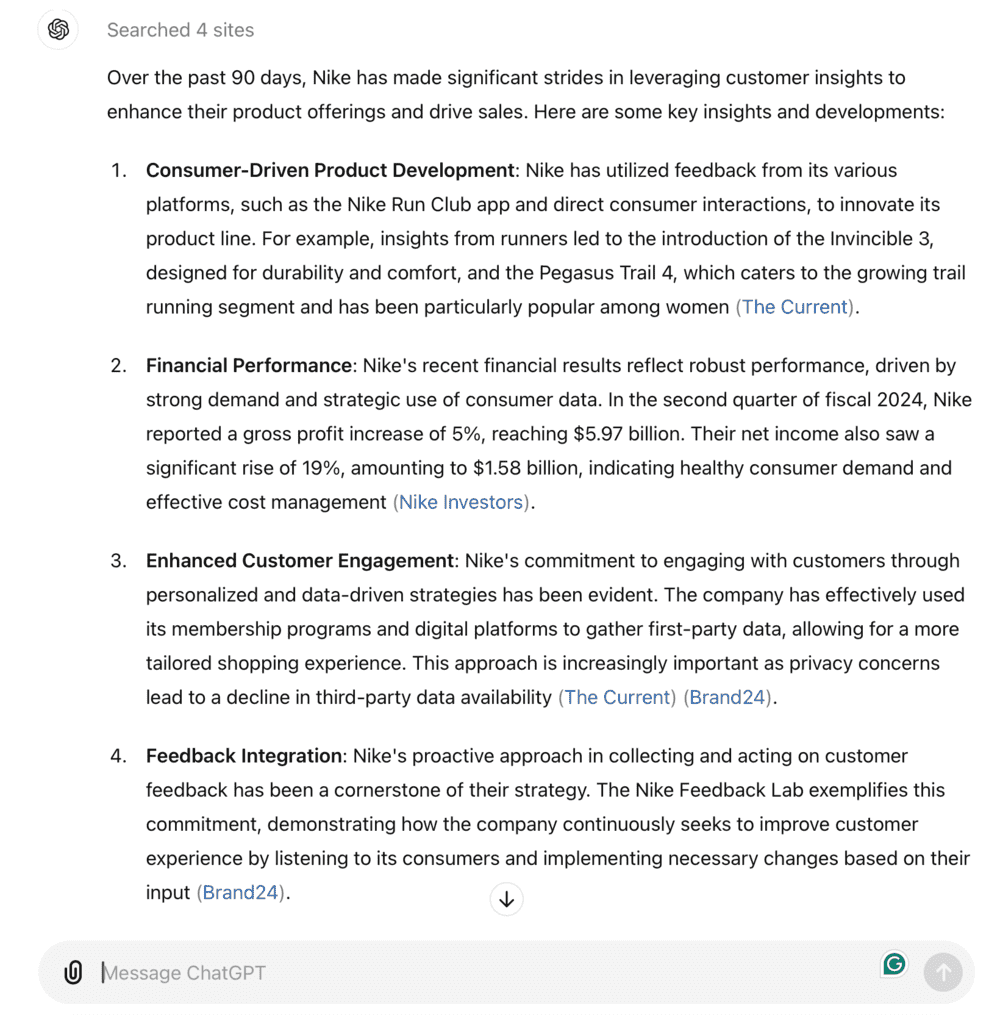
While the answer by Chat GPT is generally correct, it doesn’t tell you much for your marketing research. Unfortunately, it’s too general and quite common knowledge.
Additionally, you cannot ask Chat GPT about a specific period like “the past 90 days”.
Chat GPT cites Brand24 as a secondary data source in the 3rd and 4th point to support its answer.
However, it is a one-year-old article—clearly not information about Nike’s performance in the past 90 days.
Although it’s not entirely wrong, it’s rather useless for thorough market research.
Let’s try Perplexity, then.
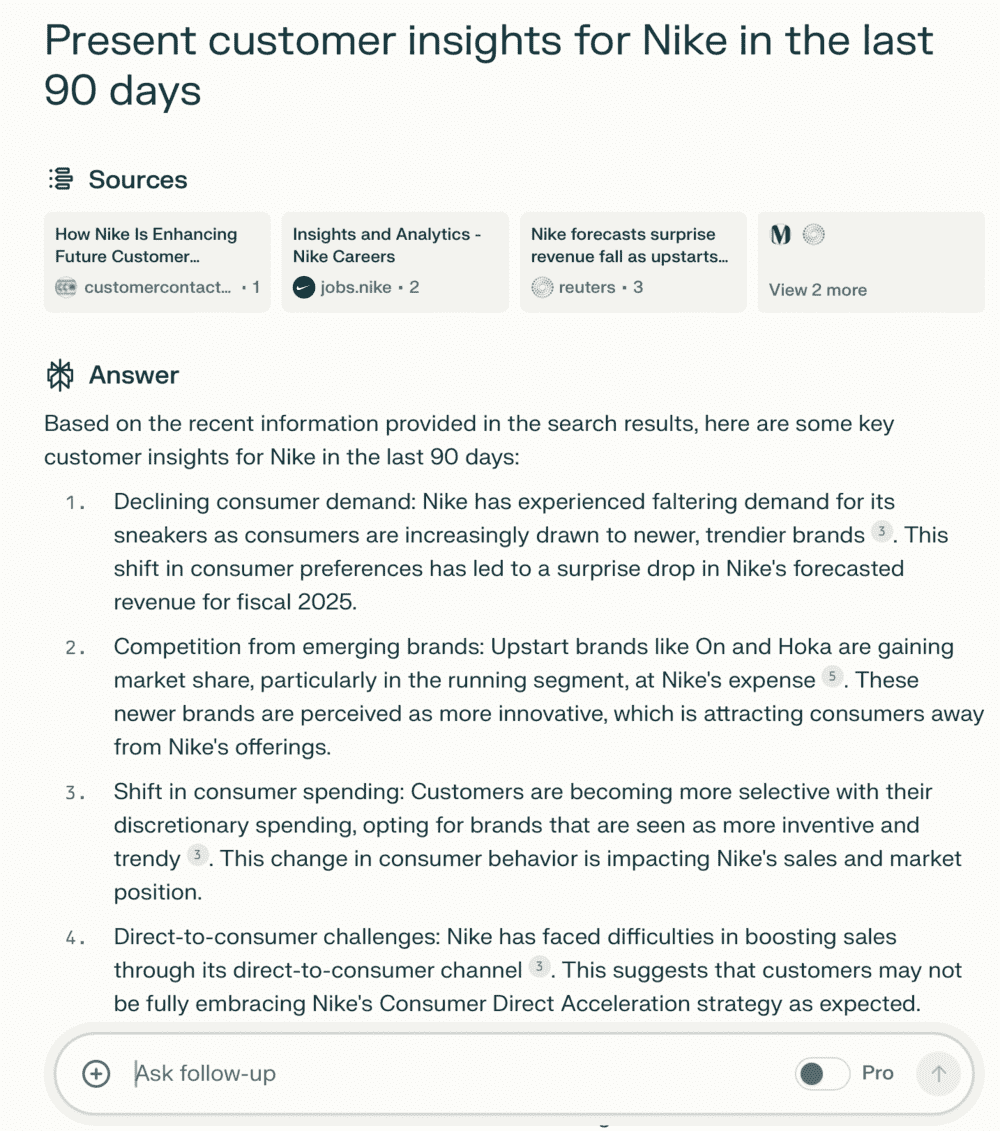
That’s another correct yet very general answer.
It is informative for someone outside the company, but I bet everybody at Nike already knows the information shared by Chat GPT and Perplexity.
This means that you need a tool that conducts primary research and provides completely new market insights.
That’s where Brand24 and its AI Brand Assistant come in.
This tool combines Chat GPT’s knowledge and language processing skills with its unique data collected through media monitoring.
By leveraging both primary and secondary research, Brand24 can provide in-depth insights into your product or service.
Additionally, by combining both qualitative and quantitative data it can conduct a thorough analysis for all target markets.
Thanks to its method, it knows:
- What people are saying about your brand online
- Which of your products is the most loved and which is the most hated
- What is your brand reach online and social media reach
- Everything about your last hashtag campaign
- How you perform compared to your competitors
- What is the AVE of your mentions
- and so much more!
Let’s ask the same question we tested on Chat GPT and Perplexity.
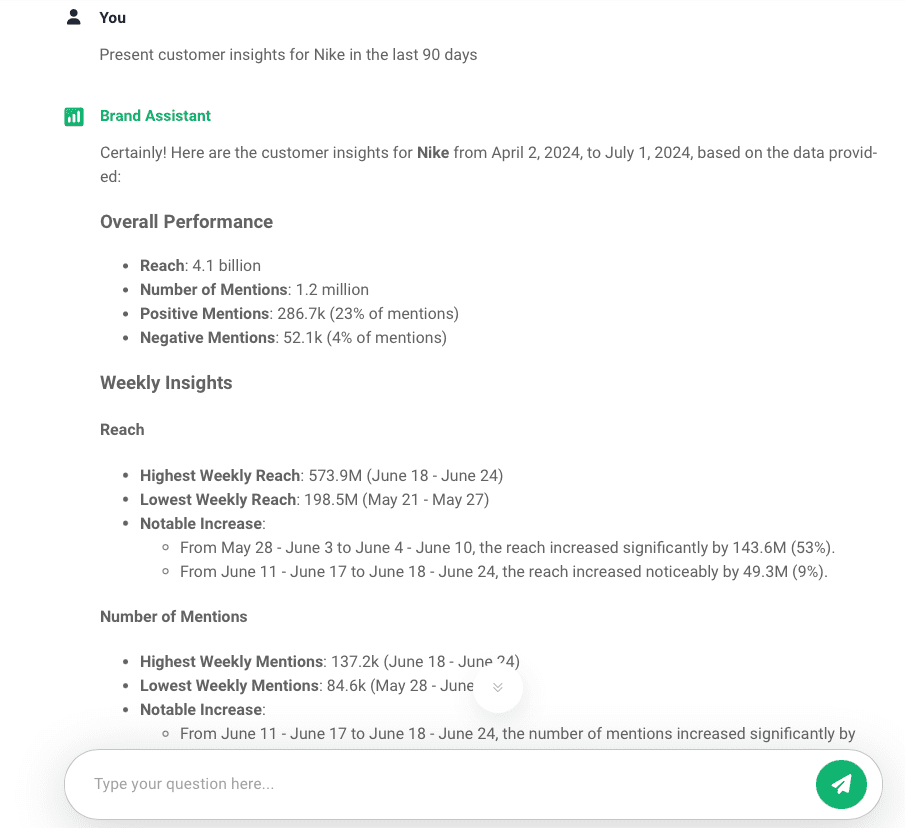
That’s what we needed!
Detailed insights into your online performance deeply informing your market research.
This critical tool combines primary research with external resources to give you ultimate insights into your market research.
There’s also a concise conclusion and a visual, so don’t worry if you don’t like digging through numbers.
Additionally, this saves you time and improves your business decisions.
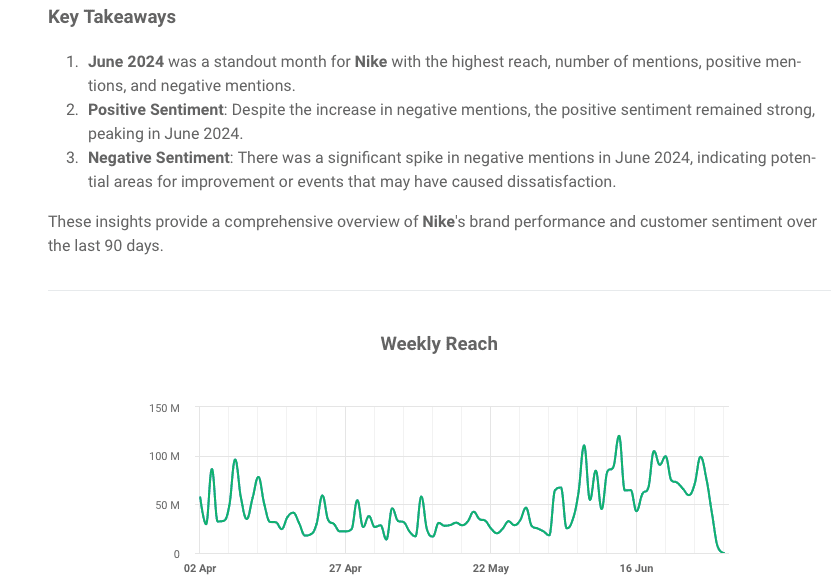
Let’s try one more question: What is the sentiment around Nike?
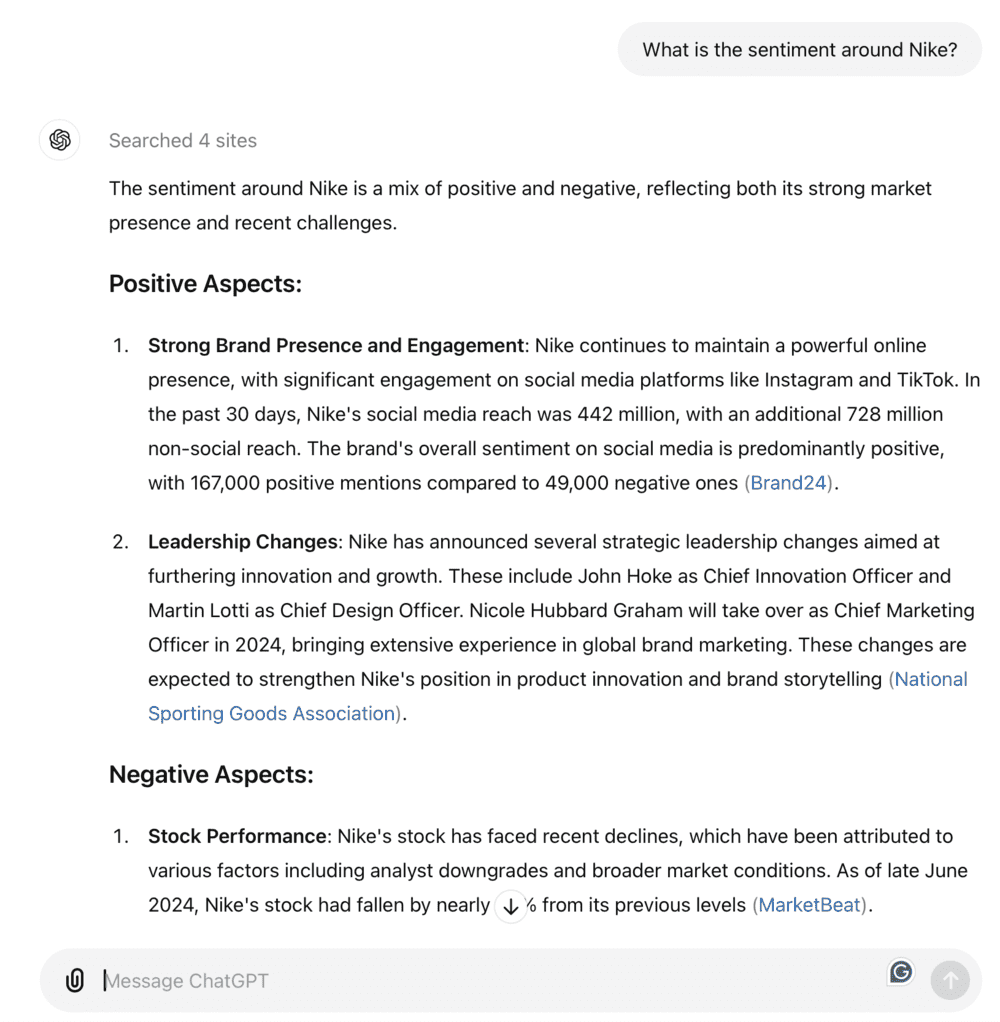
ChatGPT again tries to use Brand24 data for its secondary research, but again, it’s wrong.
That “past 30 days” is data for February 2023. Chat GPT took this information from one of our blog posts without checking the date.
This makes Chat GPT useless as:
- It doesn’t have its own data
- It tries to conduct secondary market research based on others’ data but does it wrong
What about Perplexity?
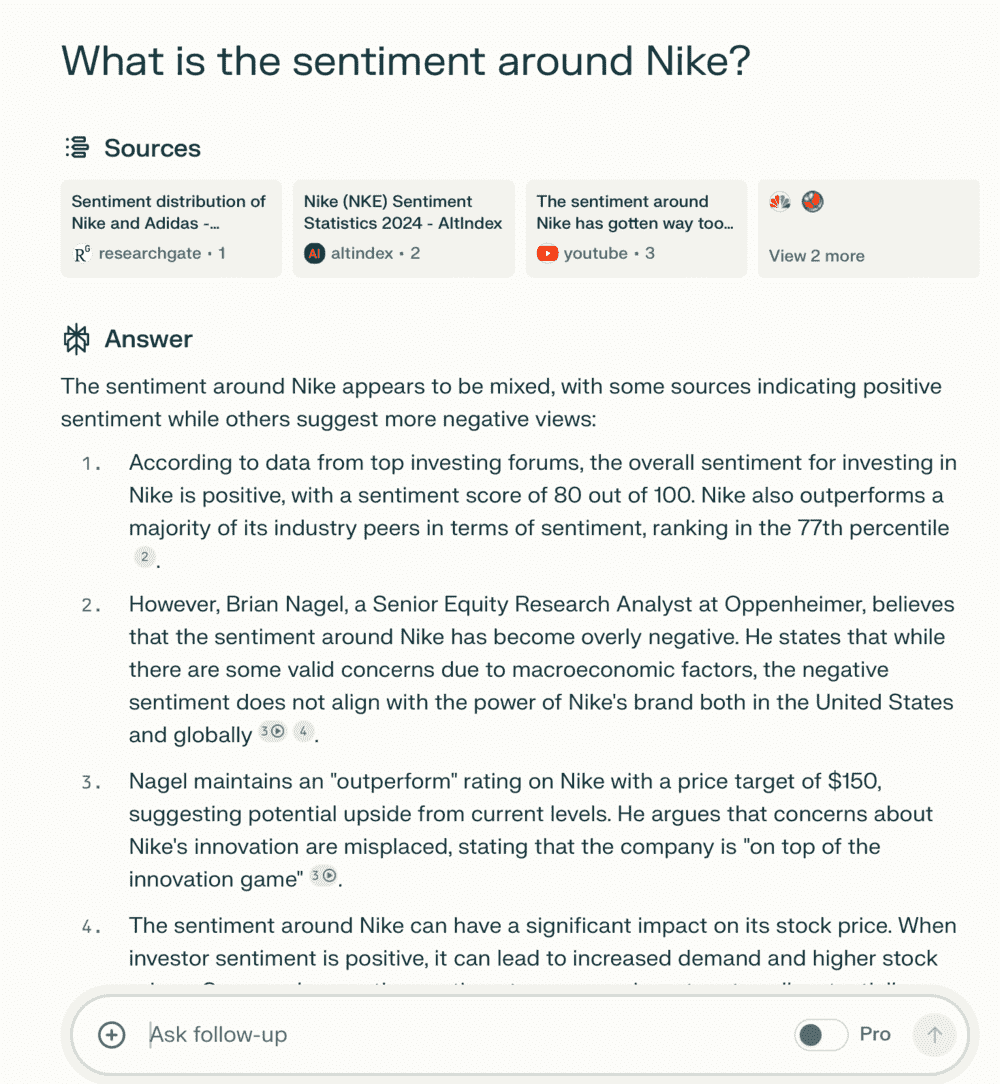
Again, the answer is not wrong, but it’s also not what you would expect. The information is too general to support market research in any way.
Let’s see what the AI Brand Assistant by Brand24 has to offer.
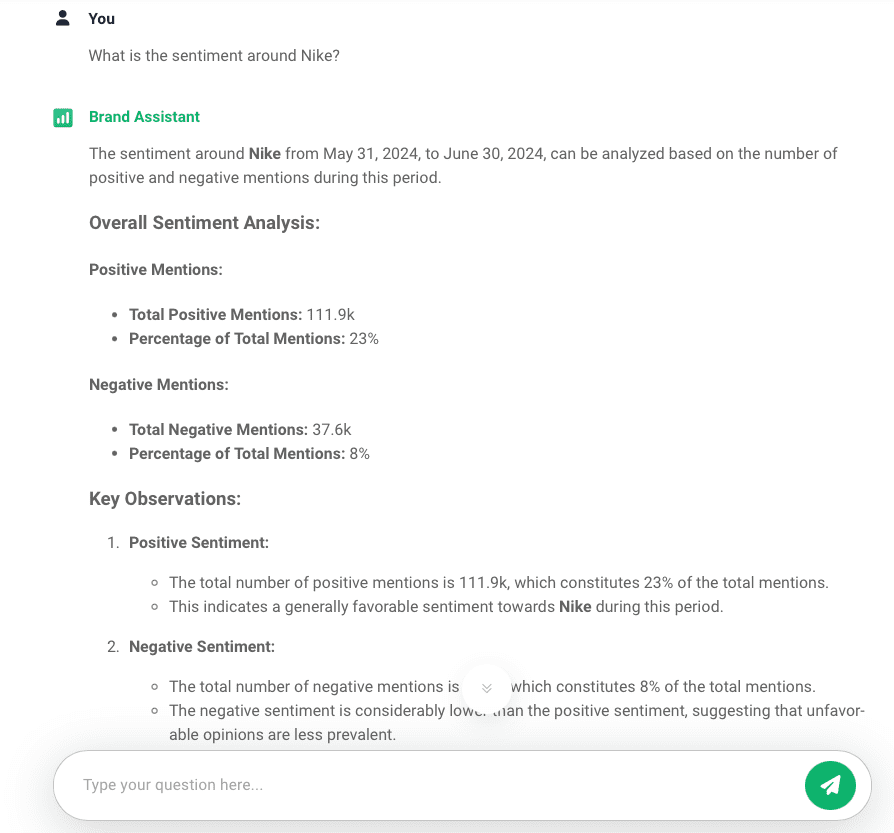
The AI Brand Assistant supports its answers with its own quantitative research results. Thanks to this, its answers are precise, up-to-date, and reflect the actual state of your brand online.
You can also ask follow-up questions.
Let’s check the reasons behind the negative sentiment around Nike.
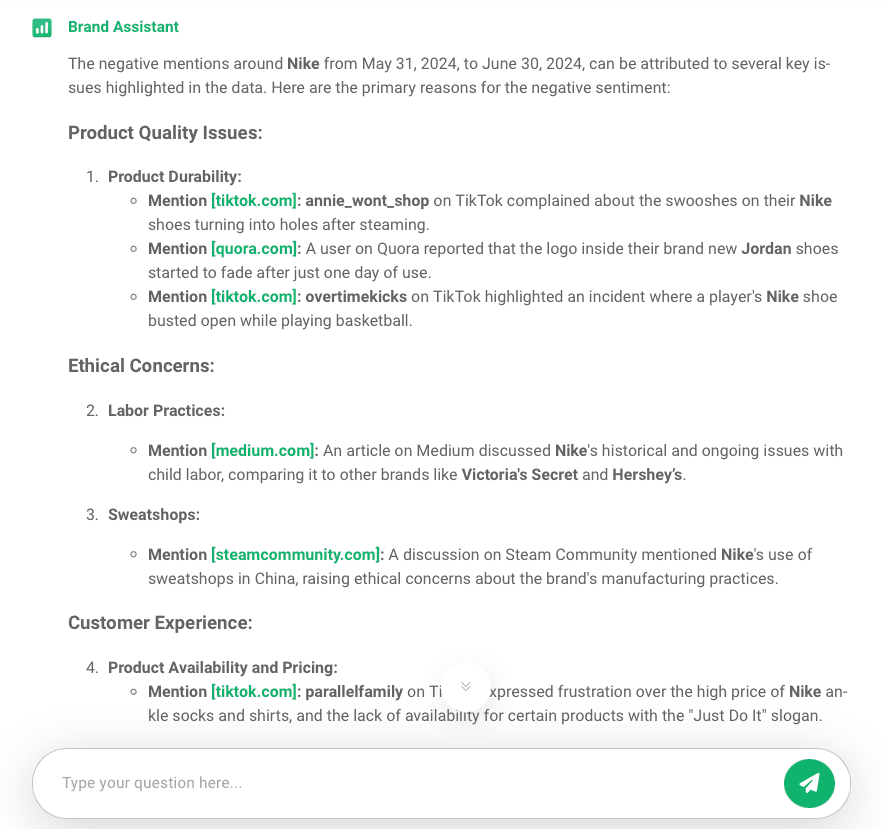
As you can see, the answer is very detailed, referencing particular mentions.
With these in-depth insights, you can adjust your marketing strategy, improve business decisions, and prevent PR crises by addressing customer needs and the most common concerns.
And what else can you ask our AI Brand Assistant regarding marketing research?
1. Which source generates the most mentions?

2. How many mentions did Nike receive in the last 30 days?
3. What is the target market for Nike?
4. What other brands appear in mentions?

5. What is the most trending topic?
6. What is the most mentioned product?
7. What time the target audience is most active on Instagram?
8. How do customers perceive Nike compared to Reebok?
9. How do customers feel about Nike?

10. What is the share of voice compared to Reebok?
11. Conduct a competitor analysis of Reebok.
12. Conduct sentiment analysis of Nike.
13. Present customer insights
And there’s so much more waiting for you to discover!
What is best is that you don’t even need to ask all those questions. You can completely delegate the market research to our AI Brand Assistant.
For instance, use this prompt: Conduct market research for Nike. Include sentiment analysis, competitors analysis, reach, and SWOT analysis.
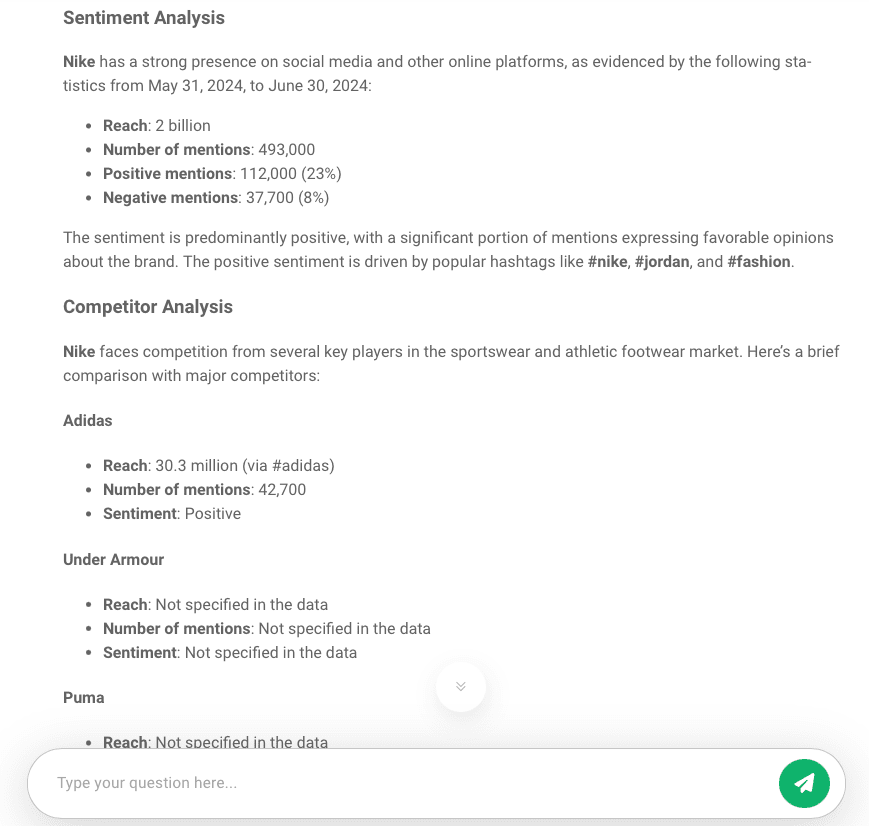
Step 2: Ask the target audience and focus groups
This is so-called primary research, meaning you collect new, original data directly from your audience or a particular focus group.
So, how to collect customer feedback?
You can ask your target customers about their preferences in survey research. These can be distributed through email, social media, or other channels.
Another option is conducting marketing research through real-time interviews.
But let’s be fair; the former is usually quite ineffective, and the latter is very time-consuming.
There are three ways for you to go.
- Use a dedicated tool to improve your customer experience with your survey. There are many solutions to choose from for your primary research. The most prominent are Google Forms, Survey Monkey, Survey Lab, and Zoho Survey.
- Delegate your whole team to do the interviews for faster results.
- Leverage social listening tools.
If I were to choose, I’d go for social listening.
Why would you generate more data when there’s already so much existing data to be analyzed online?
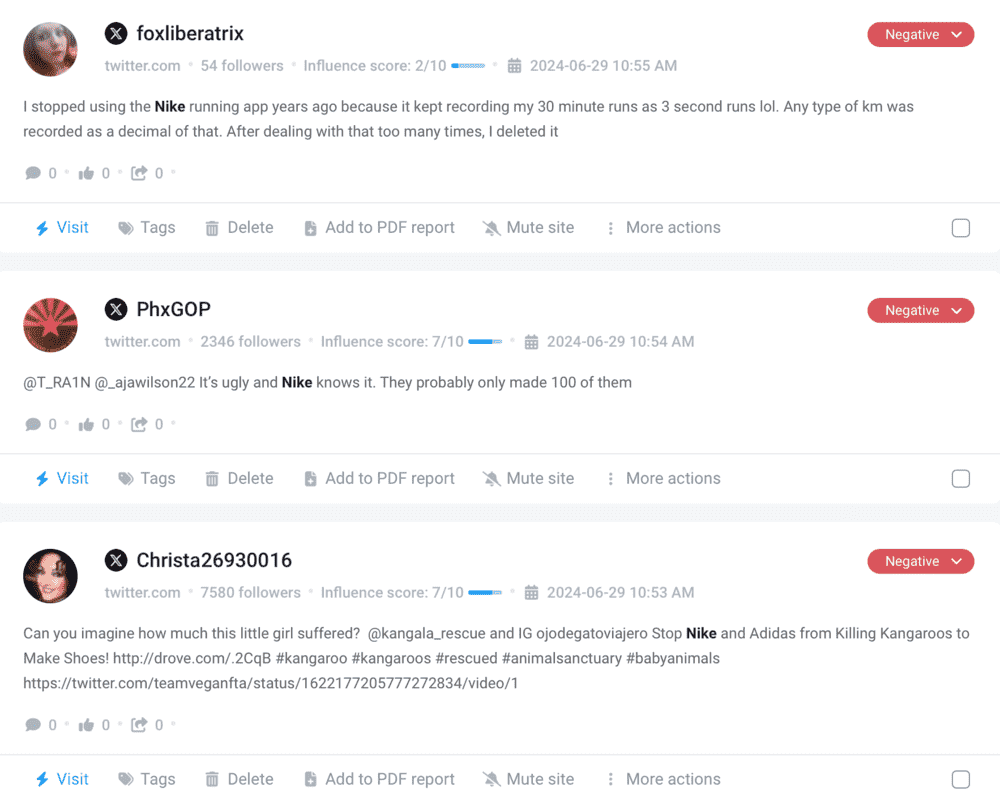
Another thing is that customer behavior changes depending on the method of conducting market research.
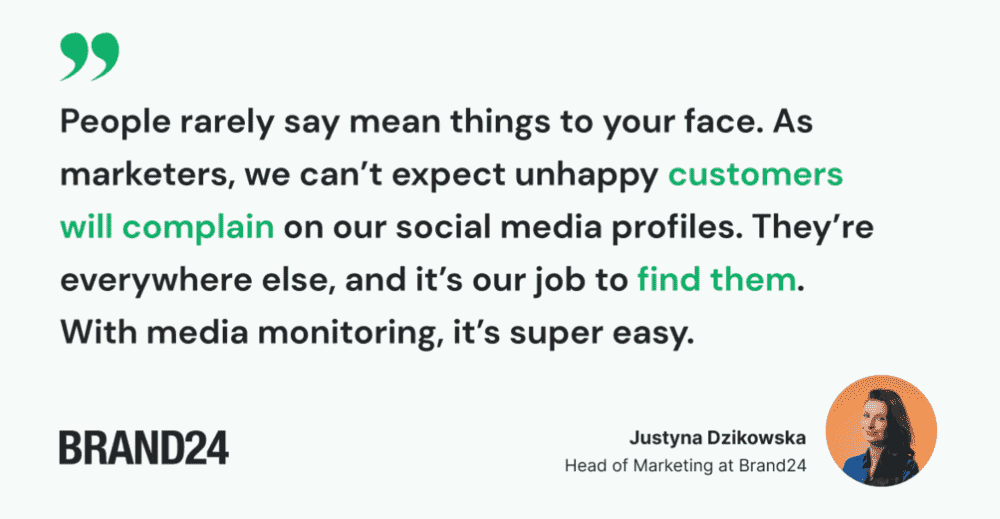
Indeed, for honest consumer insights, social media monitoring works better than any other primary research method.
Thanks to monitoring online mentions, you can also conduct exploratory research.
Take a moment to browse your customers’ words, and you may identify groundbreaking market research insights.
There may be aspects of your company that you never thought of as issues, opportunities, etc.
Primary research with Brand24 can inform your strategy and lead you to completely new discoveries and conclusions.
Based on them, you can create an informed strategy to better appeal to your focus groups and potential customers.
Step 3: Benchmark with competitors
Competitor analysis is the last crucial step of every marketing research.
By understanding what your competitors are doing, you can identify gaps in the market, spot market trends, and find opportunities to differentiate your brand.
It helps you benchmark your performance, see where you stand, and understand why certain competitors are more successful.
Competitive analysis also prepares you to anticipate and respond to threats, ensuring you stay competitive and innovative.
It helps you to conduct a SWOT analysis for your business as well.
In Brand24, we understand the importance of competitor research.
That’s why we offer a complex comparison feature. With its insights, you can gain a competitive edge over other companies in your niche.
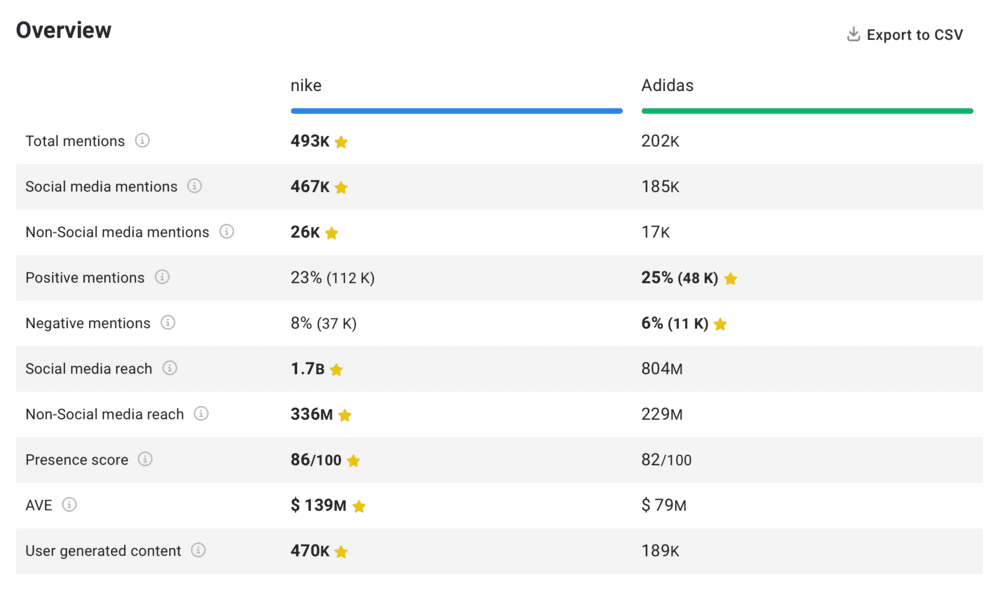
Besides the raw data analysis, you can also ask our Brand Assistant about:
- Two brands comparison

What’s great is that the tool prepares a concise conclusion with a visual.
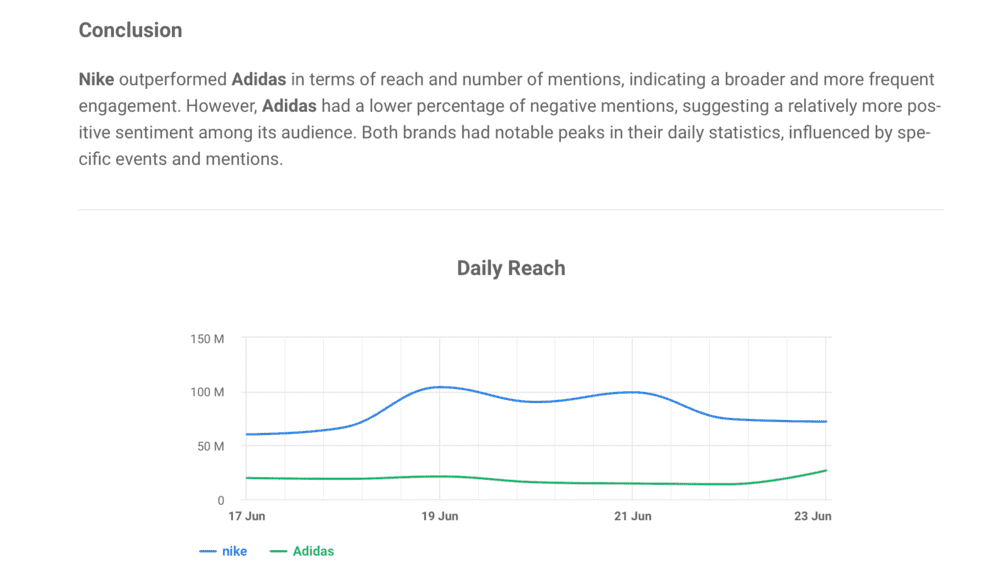
- Strategies to outperform your competitors
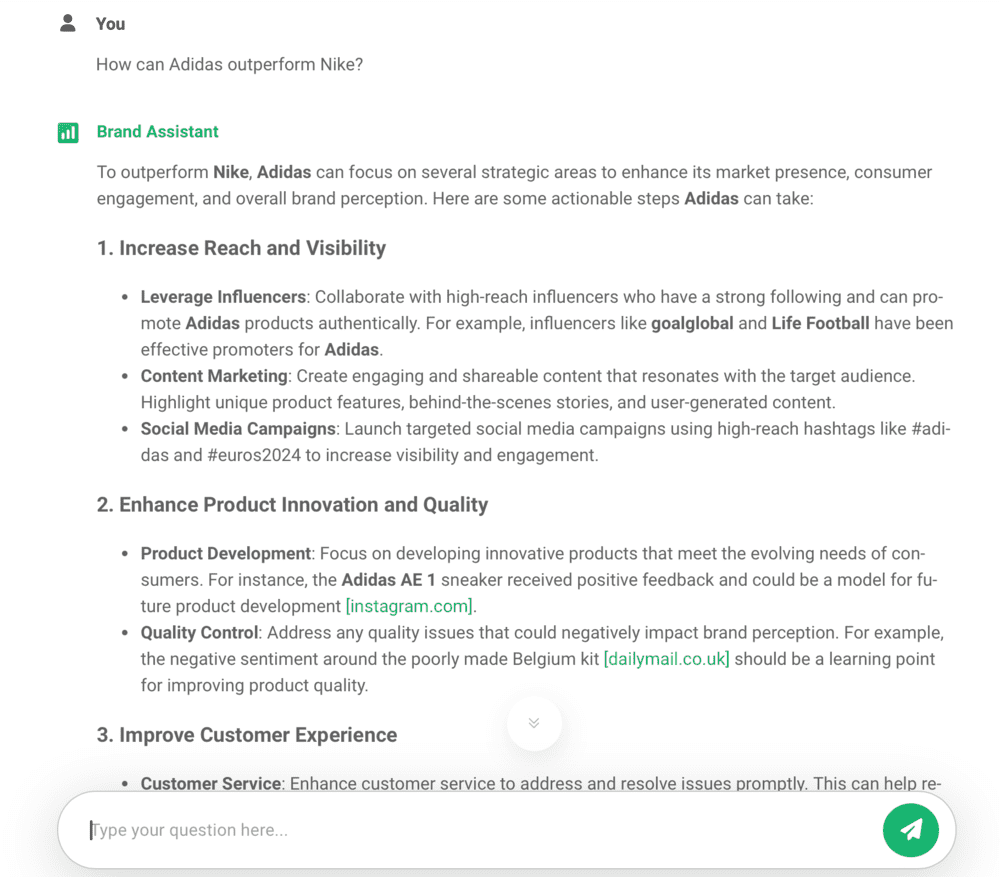
- Your competitors’ biggest mentions source
- and anything else that comes to your mind and is based on your project data.
Curious how the key players are performing on the market? Check real-time insights for brands like IKEA, Nike, or Airbnb, and much more, using the Brand Checker.
Challenges in the marketing research process
Marketing research is a critical component of business strategy, but several challenges can affect the accuracy and usefulness of the insights gathered.
Here are some of the main challenges faced when conducting marketing research:
01 Sampling issues
- Challenge: Selecting a representative market segment is crucial, but it can be difficult to access and ensure that the sample accurately reflects the target consumers.
- Solution: Use robust sampling techniques and consider multiple methods to improve representativeness. You can also set up focus groups to ensure inclusive sampling.
02 Data collection methods
- Challenge: Choosing the right data collection method can be difficult. Each method has its pros and cons, and the wrong choice can impact data quality and final results.
- Solution: Evaluate the research objectives and the characteristics of the target audience to select the best data collection method(s). Remember, media monitoring is a great starting point for any marketing research.
03 Data quality and reliability
- Challenge: Ensuring the accuracy and reliability of the data collected can be difficult, especially with self-reported data or secondary sources.
- Solution: Implement data validation techniques and cross-check data from multiple sources when possible. Leverage media monitoring tools for first-hand insights into your customer satisfaction.
04 Data analysis complexity
- Challenge: Analyzing data, especially large and complex datasets, requires specialized skills and tools. Misinterpretation of data can lead to incorrect conclusions.
- Solution: Use advanced analytical tools like Brand24 or involve skilled data analysts who can correctly interpret the data.
05 Time constraints
- Challenge: Conducting comprehensive research takes time, but businesses often need quick insights to make timely decisions.
- Solution: Plan research timelines carefully and use agile research methodologies. Start your media monitoring project before conducting market research to ensure representative and relevant data.
06 Keeping up with technological changes
- Challenge: The rapid evolution of technology means new data analysis methods and tools are constantly emerging, making it hard to stay up-to-date.
- Solution: Choose a tool that keeps up with technological developments and embraces solutions like machine learning and artificial intelligence. Brand24’s AI models have been trained for the past 12 years, ensuring a modern approach with significant reliability.
07 Respondent bias
- Challenge: Respondents may provide socially desirable answers or may not fully engage with the survey or interview, leading to biased results.
- Solution: Design surveys and interview questions carefully to minimize bias. Use techniques like anonymous surveys to encourage honest responses. Leverage social listening for brutally honest customer review examples.
08 Interpreting and communicating results
- Challenge: Even with good data, interpreting and communicating findings effectively to stakeholders can be difficult.
- Solution: Use clear, visual representations of data and tailor the communication of results to the audience’s level of understanding and interest. At Brand24, we understand this issue, so we offer a wide array of visual data representations, such as charts, graphs, and infographics.
Addressing these challenges requires careful planning, skilled execution, and ongoing adaptation to new trends and technologies in marketing research.
Conclusion
Marketing research is a challenging, time- and resource-consuming process that is prone to mistakes.
At the same time, marketing research is the key to your success. It informs your marketing strategy, provides key demographics of your clients, and helps you get ahead of your competitors.
Fortunately, with the right tool, effective market research can be done in less than 30 minutes and in 3 simple steps.
How to conduct market research?
Long story short:
- Ask AI Brand Assistant to conduct market research for you.
- Leverage primary research data from social listening to learn about customer satisfaction and focus groups.
- Benchmark with competitors to ensure your leadership in the target market.
Final thoughts:
- Marketing research helps companies better understand their business environment, consumer behavior, market size, and product or service performance. With the right tools, you can get all of those insights in less than 30 minutes.
- While tools like Chat GPT and Perplexity base their answers on secondary research, Brand24 has unique primary data about your brand that nobody else can provide.
- Brand24 combines primary and secondary research by listening to and analyzing your consumer attitudes and transforming them into unique quantitative research data.



